Understanding solar concentrators
TECHNICAL PAPER # 30 UNDERSTANDING SOLAR CONCENTRATORS By George M. Kaplan
Technical Reviewers
Dr. Thomas E. Bowman
Dr. Maurice Raiford
Jesse Ribot
Illustrated By Rick Jali
Published By
VITA
1600 Wilson Boulevard, Suite 500
Arlington, Virginia 22209 USA
Tel: 703/276-1800 * Fax: 703/243-1865
Internet: pr-info@vita.org
Understanding Solar Concentrators
ISBN: 0-86619-239-5
[C] 1985, Volunteers in Technical Assistance
Preface[edit | edit source]
This paper is one of a series published by Volunteers in Technical Assistance to provide an introduction to specific state-of-the-art technologies of interest to people in developing countries. The papers are intended to be used as guidelines to help people choose technologies that are suitable to their situations. They are not intended to provide construction or implementation details. People are urged to contact VITA or a similar organization for further information and technical assistance if they find that a particular technology seems to meet their needs.
The papers in the series were written, reviewed, and illustrated almost entirely by VITA Volunteer technical experts on a purely voluntary basis. Some 500 volunteers were involved in the production of the first 100 titles issued, contributing approximately 5,000 hours of their time. VITA staff included Maria Giannuzzi as editor, Suzanne Brooks handling typesetting and layout, and Margaret Crouch as project manager.
The author of this paper, VITA Volunteer George M. Kaplan, is the president of KAPL Associates, a consulting firm specializing in program and project management, research and development, planning, evaluation, energy, and environment. The reviewers are also VITA volunteers. Dr. Thomas E. Bowman is Professor and Head of the Mechanical Engineering Department at the Florida Institute of Technology in Melbourne, Florida. Dr. Maurice Raiford is a solar energy consultant in Greensboro, North Carolina. Jesse Ribot is an energy analyst and consultant, and has assisted in the preparation of the VITA/USAID Djibouti National Energy Assessment.
VITA is a private, nonprofit organization that supports people working on technical problems in developing countries. VITA offers information and assistance aimed at helping individuals and groups to select and implement technologies appropriate to their situations. VITA maintains an international Inquiry Service, a specialized documentation center, and a computerized roster of volunteer technical consultants; manages long-term field projects; and publishes a variety of technical manuals and papers.
I. Introduction[edit | edit source]
Although solar energy research, development, and systems experiments were conducted in the late 1800s and early 1900s, it was the sharp increase in the price of oil in 1974 precipitated by the Middle-Eastern oil embargo the previous year that escalated national and international investment in solar energy. In the United States and other industrial countries, the technological tools and advancements produced during World War II, the post-war rebuilding and prosperity, the U.S. nuclear power and space programs, and other technological achievements were applied to solar energy research and development. The result was that research, which had been limited to backyard tinkerers and small specialized companies, was spread to universities, national laboratories, and industry. The federal solar budget rose from less than $1 million in early 1970s to over $1 billion in the early 1980s; the budget is now about $200 million, with about $50 million for solar thermal technology.
Solar thermal technology is concerned principally with the utilization of solar energy by converting it to heat. In the concentrating type of solar collector, solar energy is collected and concentrated so that higher temperatures can be obtained; the limit is the surface temperature of the sun. However, construction materials impose a lower, more practical limit for temperature capability. Similarly, overall efficiency of energy collection, concentration, and retention, as it relates to energy cost, imposes a practical limit on temperature capability.
If solar energy were very highly concentrated into a tiny volume, the result would approach a miniature sun. If the same energy were distributed along a thin line, the line would be cooler than the miniature sun, but still hot. If distributed on a large surface, the surface would be less hot than the line. There are solar concentrators that focus sunlight into a point or a line. There are also non-focusing concentrators. Each type has preferred temperature-dependent applications.
The amount of energy per unit area that can be collected annually by a concentrator depends on the positioning of the concentrator relative to the sun. Some types of collectors perform adequately (cost effectively) if left in a fixed position. These collectors generally have limited temperature capability, and provide little or no concentration of the incident sunlight. Most concentrators would collect so little energy in a fixed position that they must be provided with the capability to daily track the sun from morning (east) to sunset (west) to be cost-effective. Some concentrators can only be cost effective by tracking both the sun's daily path and the sun's annual inclination (which causes the sun to appear to move in declination by 47 [degrees] over the year). Thus, concentrators may be non-tracking, single-axis tracking (which tracks east to west), or two-axis tracking (which tracks both east to west and north to south). Two-axis tracking provides the maximum solar energy collection but is not cost effective for most applications or collector designs.
The U.S. national solar energy research program has led the world both in investment and breadth of program. Because the potential U.S. market is large, the U.S. national program was aimed at the domestic market and was not intended specifically for export. Thus, the U.S. experience is primarily applicable to the U.S. and may not be relevant to other countries without modification.
For U.S. applications, for example, mirror-type concentrators are more cost effective than lens-type concentrators for small, intermediate, and large systems for heat generation and use. Tracking systems appear most effective for high-temperature applications. However, the effectiveness in the U.S. may be due to sophisticated technology, availability of skilled maintenance personnel and spare parts, an excellent supporting infrastructure, rather than an inherent advantage of mirrors or tracking systems. In a less industrialized environment, lens concentrators may prove more appropriate.
Although the terms "collector" and "concentrator" are used interchangeably in this paper, the terms are distinctive. A collector may not concentrate solar radiation, while concentrators are considered collectors. No distinction will be made in this paper unless necessary.
HISTORY OF SOLAR CONCENTRATORS[edit | edit source]
The concept of concentrating solar rays to heat a target area has been known for at least 4,000 years. In the clay tablet period of Mesopotamia, polished gold vessels were reputedly used to ignite altar fires. Archimedes is said to have saved Syracuse from invasion by burning the Roman fleet with concentrated solar rays reflected from polished metal.
Experiments to verify the story of Archimedes were performed in the seventeenth century with polished metal plates. Glass lenses were first used to smelt iron, copper, mercury, and other materials from their ores in the seventeenth century. The eighteenth century brought solar furnaces and solar ovens. Advancing tech-in the nineteenth century produced steam engines and hot air engines operated with solar energy. Numerous solar engines and solar furnaces were constructed early in the twentieth century. Experimentation continued into the 1930s before languishing as inexpensive fossil fuels, particularly natural gas, became widely available.
The U.S. solar energy program was initiated in 1970 as part of the Research Applied to National Needs (RANN) program of the U.S. National Science Foundation. This program expanded enormously as a result of the oil embargo of 1974 and the price rise of oil and other fossil fuels. As the program goals changed from research and development and later to commercialization, program responsibility shifted to other federal agencies. The program is now part of the U.S. Department of Energy; the focus is again on long-term high-cost, high-risk research and development unlikely to be undertaken by industry; responsibility for commercialization has been shifted back to industry.
NEEDS SERVED BY THE TECHNOLOGY[edit | edit source]
Solar concentrators provide high energy density solar radiation to a target receiver, thus raising the temperature of the target. Depending on the degree of concentration, the optical properties (solar absorption and radiation) of the target surface, and the target's cooling rate, the following may occur:
- the target will melt (high concentration);
- the target will reach an equilibrium temperature with natural cooling (modest concentration); or
- the target will reach an equilibrium temperature with a forced (circulating) coolant (intermediate concentration).
The first instance is that of a solar furnace. The second may be considered a solar cooker or solar oven. In the third instance, the heated coolant is used directly as, for example, hot water or steam in home or industrial applications, or indirectly, as a vapor (steam) to generate electricity. In the case of electricity production, common energy conversion devices provide an intermediate step--shaft rotation--between the heated fluid and conversion to electricity.
If the target of the concentrated sunlight is a photovoltaic cell, or an array of cells, electricity will be produced directly. The degree of solar concentration, cell conversion efficiency, the design of the cell assembly, and the cell material will determine if natural circulation or forced circulation cooling is necessary for efficient operation of the cell. Currently, the cost/unit area of a concentrator is less than the cost/unit cell area. As a result, concentrators are used to reduce cell area. Should the cell area become less expensive than the concentrator area, concentrators would not be utilized.
This paper deals principally with concentrators for thermal applications rather than for applications with photovoltaic cells. Emphasis is placed on applications in less developed countries.
II. OPERATING PRINCIPLES[edit | edit source]
SUNLIGHT[edit | edit source]
Before discussing concentrators, a few words about the sun are in order. Beyond the earth's atmosphere the intensity of sunlight is about 1,350 watts per square meter (429 British thermal units [Btu] per hour per square foot). Passage through the atmosphere depletes the intensity due to absorption by the various gases and vapors in the air and by scattering from these gases and vapors and from particles of dust and ice also in the air. Thus, sunlight reaching the earth is a mixture of direct (unscattered) and diffuse (scattered) radiation. At sea level the intensity is reduced to approximately 1,000 watts/square meter (295 Btu/hour/ square foot) on a bright clear day. The intensity is further reduced on overcast days.
Most concentrators utilize direct radiation only. These concentrators work well on bright clear days, poorly on hazy days, and not at all on drab gray days when the sunlight intensity is reduced and the light consists principally of diffuse radiation. Another limiting factor is that the sun is not a point but has a diameter equivalent to about one-half degree of arc. Concentrator design must consider this arc.
GENERIC TYPES AND USE[edit | edit source]
Although the discussion that follows deals with concentrators as entities, concentrators are only a portion of an energy collection system. To be useful the concentrated rays must be directed to a target called a receiver, which converts the rays into another form of energy, heat. The concentrator and receiver must be matched for optimum performance. Frequently, the receiver is expected to impart heat to a fluid in order that the heat be utilized or dissipated. When the main purpose of the concentrator is to obtain heat effectively, then the combination of concentrator and receiver must be carefully designed to reduce stray loss of energy from either the concentrator or receiver.
There are many ways to characterize concentrators. These include:
- Means of concentration--reflection or refraction
- Point, line, or non-focusing
- Fixed or tracking concentrator
- Fixed or tracking receiver
Means of Concentration[edit | edit source]
Concentration of light is achieved with mirrors (reflection) or with transparent lens (refraction). Cameras and small telescopes use lenses; large telescopes use mirrors. A mirror reflects incoming light so that the angle of the reflected ray is equal to the angle of the incident ray (Figure 1). This relation also

holds when the mirror is tilted (Figure 2). A single flat mirror
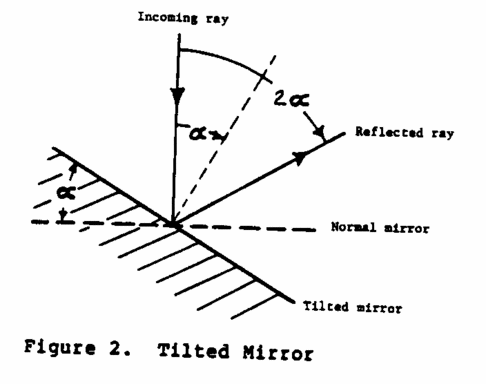
does not concentrate but concentration can be obtained by superimposing the reflections of many mirrors. Alternately, concentration can be achieved by bending the mirror into a pre-determined shape and relying on the optical properties of the resulting curved surface.
The lens relies on bending (refracting) incoming light so as to converge to a common focus (Figure 3). As the size of the lens
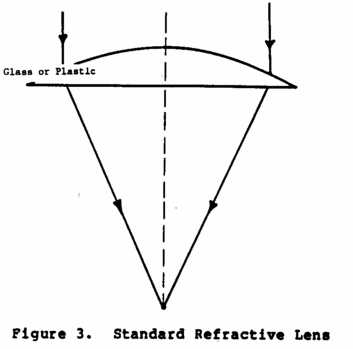
increases, lens thickness also increases. A Fresnel lens (Figure 4)

maintains the optical characteristics of the standard lens by retaining the same curvature piecewise. This permits a significant reduction in the thickness and weight of the lens with only a modest performance penalty.
Each method of concentration has drawbacks. The mirror requires a clean smooth reflecting surface: clean since dust particles could scatter light away from the receiver or the light could be partly absorbed by a thin dirty film; smooth because contour error can also result in missing the receiver. The reflecting material may be placed on the surface of the mirror (first surface, Figure 5), or behind a transparent surface (second surface,
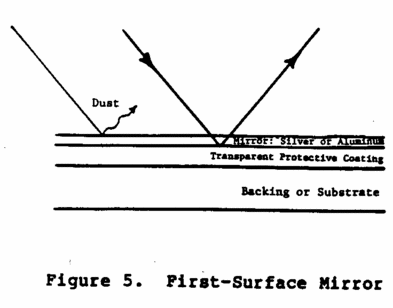
Figure 6). Silver is the preferred reflector material with
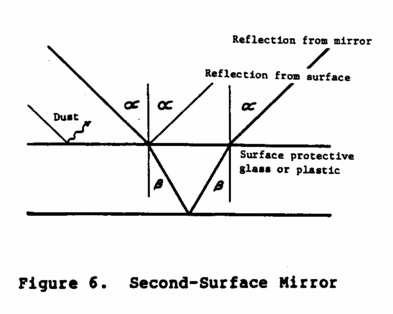
aluminum second. Silver is very susceptible to degradation by moisture and airborne contaminants. Available protective coatings have not proven effective for silver in first surface application. Aluminum is more durable but less reflective. Second-surface mirrors have some energy loss due to absorption of light by the transparent surface, usually glass or plastic, as the light is incident and as it is reflected through the material. Low-iron glass is preferred over high-iron glass because of reduced absorption of light. If plastic is used, it must be stabilized against degradation by the ultraviolet light of the sun.
Because of the greater thickness of the lens, the degree of energy absorption is higher than that of the second surface mirror. The Fresnel lens, which can be made much thinner than a standard lens, has less energy loss due to energy absorption than the standard lens.
The lens surface must also be clean and smooth for the same reasons as for the mirror. Fresnel lens performance is enhanced when the vertical portion has little or no slope error. Plastics can be formed to produce Fresnel lens of higher quality and less cost than with glass. However, plastic lenses tend to deteriorate under ultraviolet light and must be stabilized.
Point, Line, or Non-Focusing[edit | edit source]
One criterion for selection of a specific concentrator is the degree of concentration and hence temperature that is to be achieved. As a rule, concentrating energy onto a point produces high to very high temperature; and onto a line, moderate to high temperature. Non-focusing concentrators produce low to moderate temperature.

The parabolic dish reflector (Figure 7) utilizes the optical properties of the parabolic curved surface to concentrate direct light to the focal point. The dish geometry is familiar being used for automobile headlights, searchlights, radar, and to receive transmissions from broadcast satellites.
Standard circular and Fresnel lenses are also point focus concentrators. The Fresnel lens has been utilized in conjunction with photovoltaic cells in several test installations in the United States and abroad.
The overlapping images from many flat mirrors can be considered the equivalent of point focusing. The focal shape is not a point but rather the finite image of the sun further broadened by the characteristics of the reflector material and various errors in manufacture and in the precision of image overlap. Figure 8

illustrates the central receiver concept wherein heliostats (flat or slightly curved mirrors mounted on tracking devices) redirect the sun's rays toward a receiver atop a tower. A 10-megawatt electrical generating plant employing this principle has been successfully operated in California since 1982.
Line. The parabolic trough (Figure 9) is an example of line focus
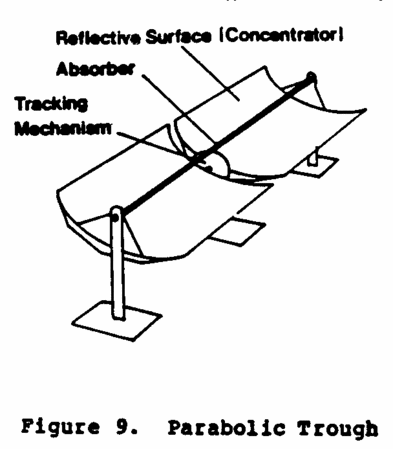
optics. The incident direct radiation is reflected from the trough to the focal line the length of the trough. To maximize energy collection the trough is designed to track the sun. The trough may be oriented with the focal line running east-west, north-south, or north-south with simultaneous tilt toward the sun (polar mount).
Each orientation has its own seasonal and yearly collection characteristics. No one orientation is universally preferred (i.e., is more cost-effective).
The standard and Fresnel lenses can be fabricated in linear form (Figure 10) with the same cross section as the circular lens but
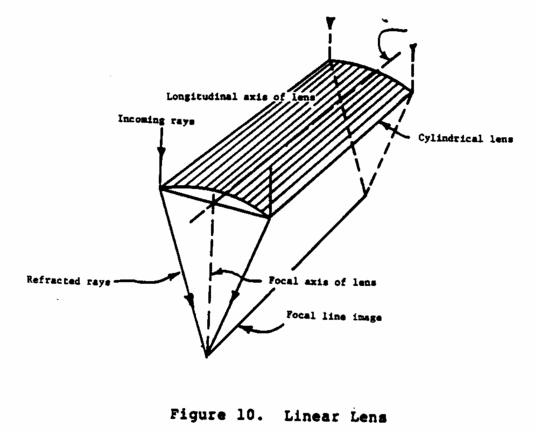
now producing a focal line instead of a focal point. Plastic linear Fresnel lenses of good quality can easily be produced by extrusion.
The hemispherical bowl (Figure 11) is another example of linear

focal optics. Unlike the trough or lens, two-axis tracking is mandatory. The hemispherical bowl is always fixed, and the receiver does the tracking. The focal line falls on the line connecting the center of the sphere with the sun. The focal line is restricted to the lower half of the radius by the optical properties of the bowl. Because some rays reach the focal line with only one reflection and others require multiple reflections, the intensity is not uniform along the length of the focal line. Figure 12 shows a 65-foot (19.7-meter) diameter experimental bowl
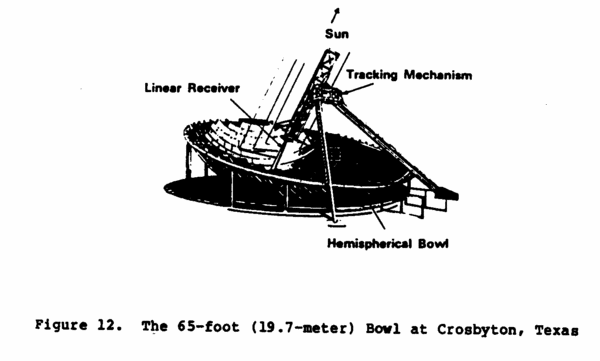
that has operated successfully in Texas for many years. Annual energy collection is lower than for other collector optics and there appears to be no compensating advantages, except that it is much easier for a small receiver to track the sun's image than it is for a larger and much heavier concentrator.
Non-Focusing. The hemispherical trough (Figure 13) and the flat

plate collector with booster mirrors are examples of concentrators that are non-focusing. Non-focusing concentrators do not focus sunlight into a specific geometrical shape, but reflect sunlight onto a receiver, thus increasing the total amount of sunlight received. The category of non-focusing concentrators also includes concentrators in which the focus is of poor quality. The cylindrical collector (Figure 14), a variation of the
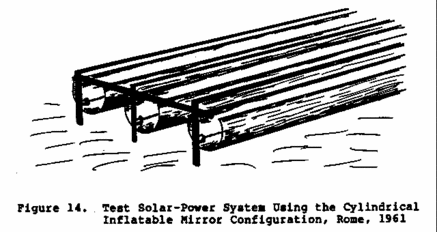
hemispherical trough, is of interest because the entire cylinder may be fabricated with inexpensive, inflatable plastic.
A simple method of achieving a modest increase in concentration on a large area is to use booster mirrors in conjunction with a flat plate collector (Figure 15). Before noon the mirrors face
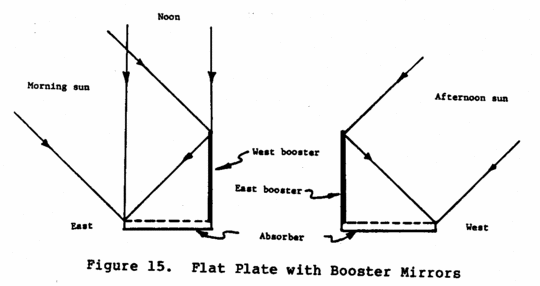
east; after noon they face west. The energy collection advantage of boosters for a flat plate collector is shown in Figure 16.

Fixed or Tracking Concentrators[edit | edit source]
Maximum energy collection on a daily or annual basis requires tracking of the sun (or the sun's reflected image) since concentrators, particularly those capable of high concentration, utilize only direct radiation. Thus a parabolic dish, when pointed at the sun, has reflected rays passing through the focus. As the sun moves, some of the reflected rays will miss the focus and, in time, all will miss the focus. The dish must be moved to maintain the reflected rays at the focus. The central receiver, parabolic dish, parabolic trough, standard lens, and Fresnel lens are examples of tracking concentrator systems.
The hemispherical bowl likewise must continuously track the sun. Large bowls are too unwieldly to move. Thus, the receiver is moved continuously instead. It tracks the focal line of the sphere (the reflected image of the sun) throughout the day.
Like the hemispherical bowl, the Russell concentrator is fixed and the receiver must track the sun's image (Figure 17). This

concentrator consists of long narrow mirrors whose centers all fall on the perimeter of a circle. The mirrors are oriented so that all reflected images focus on a point on the same perimeter. As the sun moves the focus moves along the perimeter. The Winston collector is usually considered a non-tracking concentrator. Its energy collection can be increased by tracking. As a trough-type collector (Figure 18), it consists of a parabolic
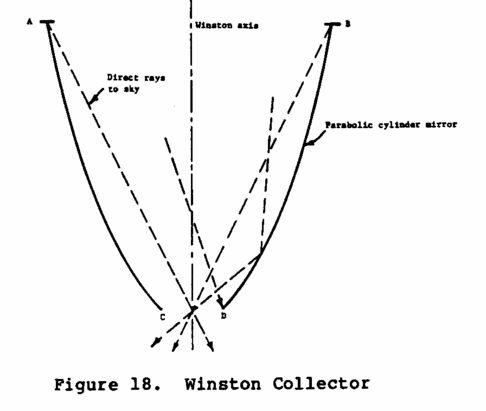
surface whose axis is horizontal and whose focal point is close to the surface. The collector is frequently found as a paraboloid in shape but can also be in trough form. The collector accepts both direct and diffuse radiation. The acceptance angle (angle of acceptance of sunlight) depends on the height of the parabola. The shorter the height, the greater the acceptance angle and the period of daily operation, but the less the concentration and maximum temperature capability. The collector has been utilized as a highly effective fixed collector, which reaches higher temperature than a typical flat plate collector.
Fixed or Tracking Receivers[edit | edit source]
The central receiver and parabolic trough have fixed receivers, due to the optical characteristics of the systems. The parabolic dish receiver is usually positioned at the focus so as to move with the dish as the dish tracks the sun. Neither the bowl nor the Russell collector track the sun, hence their receivers must track the sun's image. The Winston collector, the cylindrical collector, and the flat plate collector with booster mirrors are normally utilized in fixed position and with fixed receivers. The flat plate is, of course, both the collector and the receiver.
Other Fixed Concentrators[edit | edit source]
There are many ingenious concentrators that work quite well and can be cost effective in some applications. The cusp collector (Figure 19), whose surface geometry is the locus of the position
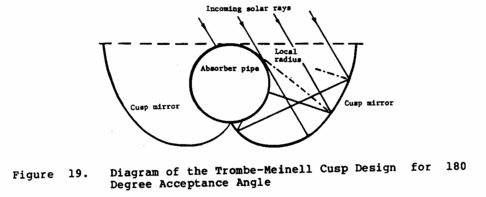
of the end of a string as it is unwrapped from a pipe can provide a modest concentration suitable for hot water. A conical collector (Figure 20) can be substituted for the Winston paraboloid,

gaining simplicity of manufacture with some performance penalty. Similarly, flat reflectors can substitute for the parabolic sides of the Winston trough collector.
Table 1 summarizes the characteristics and potential uses of the concentrators described above.
Type of Concentrator: Parabolic Dish
Type of Focus : Point
Lens or Mirror : Mirror
Sun's Concentration : > 1000
Tracking : Yes
Tracking Receiver : Yes
Temperature (C) : >2638
Temperature (F) : >3000
Typical Application : Electricity
Comments : Small-scale appilcations
Type of Concentrator: Central Receiver
Type of Focus : Point
Lens or Mirror : Mirror
Sun's Concentration : > 1000
Tracking : Yes
Tracking Receiver : No
Temperature (C) : >2638
Temperature (F) : >3000
Typical Application : Electricity
Comments : Large-scale appilcations
Type of Concentrator: Lens (Round)
Type of Focus : Point
Lens or Mirror : Lens
Sun's Concentration : > 1000
Tracking : Yes
Tracking Receiver : No
Temperature (C) : >2638
Temperature (F) : >3000
Typical Application : Electricity
Comments : Photovoltaic cells
Type of Concentrator: Parabolic Trough
Type of Focus : Line
Lens or Mirror : Mirror
Sun's Concentration : 100
Tracking : Yes
Tracking Receiver : No
Temperature (C) : 538
Temperature (F) : 1000
Typical Application : Electricity, Heat
Comments : Small or Large Systems
Type of Concentrator: Fixed Mirror Moving Focus
Type of Focus : Line
Lens or Mirror : Mirror
Sun's Concentration : 100
Tracking : No
Tracking Receiver : Yes
Temperature (C) : 538
Temperature (F) : 1000
Typical Application : Electricity, Heat
Comments : Small or Large Systems. Not economic is U.S. experience
Type of Concentrator: Lens (linear)
Type of Focus : Line
Lens or Mirror : Mirror
Sun's Concentration : 100
Tracking : Yes
Tracking Receiver : Yes
Temperature (C) : 538
Temperature (F) : 1000
Typical Application : Electricity, Heat
Comments : Small or Large Systems. Little U.S. experience
Type of Concentrator: Sphere
Type of Focus : Line
Lens or Mirror : Mirror
Sun's Concentration : 80
Tracking : No
Tracking Receiver : Yes
Temperature (C) : 538
Temperature (F) : 1000
Typical Application : Electricity
Comments : Awkward in large scale
Type of Concentrator: Cylinder
Type of Focus : Line
Lens or Mirror : Mirror
Sun's Concentration : 2
Tracking : No
Tracking Receiver : No
Temperature (C) : 121
Temperature (F) : 250
Typical Application : Heat
Comments :
Type of Concentrator: Cusp
Type of Focus : Line
Lens or Mirror : Mirror
Sun's Concentration : 1.5-2.5
Tracking : No
Tracking Receiver : No
Temperature (C) : 121
Temperature (F) : 250
Typical Application : Heat
Comments :
Type of Concentrator: Winston
Type of Focus : Line
Lens or Mirror : Mirror
Sun's Concentration : 3-6
Tracking : No
Tracking Receiver : No
Temperature (C) : 121
Temperature (F) : 250
Typical Application : Heat
Comments : Concentration decreases as acceptance angle increases
Type of Concentrator: Flat plate w/ Booster
Type of Focus : Area
Lens or Mirror : Mirror
Sun's Concentration : Between 1 and 2
Tracking : No
Tracking Receiver : No
Temperature (C) : 121
Temperature (F) : 250
Typical Application : Heat
Comments :
ANNUAL ENERGY COLLECTION EFFICIENCY[edit | edit source]
Collectors that maintain their surfaces facing the sun (right angle for most collectors) have the highest annual collection efficiency. The parabolic dish and other two-axis tracking collectors are examples. The central receiver, although a two-axis tracking system, does not direct the heliostat reflectors to face the sun but rather maintains an angle to the sun so that the image is reflected to the receiver. As expected, its collection efficiency is lower than the dish. The parabolic trough is a single-axis tracking system; thus, the surface is only occasionally at a right angle to the sun and has a lower annual collection efficiency than the central receiver.
Fixed collectors with tracking receivers such as the bowl and Russell collector have even lower collection efficiency. The least efficiency is exhibited by Winston and other fixed collectors and receivers.
The theoretical annual efficiency of the three principal concentrating collectors utilized in the United States is 80 percent for the dish, 60 percent for the central receiver, and 43 percent for the parabolic trough on an annual basis. Collector efficiency is determined for the period extending from the beginning of tracking when the sun climbs to 15 degrees above the horizon until tracking stops when the sun declines below 15 degrees at the end of the day. The efficiency depends on direct solar radiation and system optics.
Actual efficiency depends on mirror or lens surface accuracy, surface dust and film, energy absorption by lens or mirror, the properties of the reflecting, material, pointing accuracy, effects of temperature variations on these factors, weather--including clouds, dust and haze, and so on. The efficiency is further reduced by receiver performance and receiver subsystem design, including care given to reduction of heat loss by conduction, convection, and radiation.
III. DESIGN VARIATIONS AND EXPERIENCE[edit | edit source]
PARABOLIC SOLAR COLLECTORS[edit | edit source]
A recent paper on the parabolic dish prepared by the Jet Propulsion Laboratory(*) describes nine designs sponsored by the U.S.
(*) V.C. Truscello, "Status of the Parabolic Dish Concentrator, Proceedings of the Energy Research and Development Agency Conference on Concentrating Solar Collectors, Georgia Institute of Technology, September 26-28, 1977 (Washington, D. C.: U. S. Department of Energy, undated, circa 1982-1983).
Department of Energy, eight privately-funded U.S. designs, and 10 dishes developed by other countries. Although no two dishes are identical, they fall into four categories:
1. Rigid reflector. The reflective surface is attached to a rigid curved structure. This is the standard (radar type) structure (Figure 21).
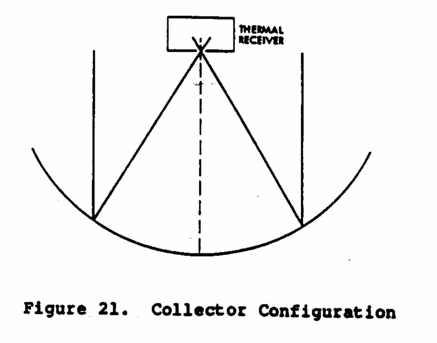
2. Pressure-stabilized membrane. The reflective surface is attached to a flexible membrane, which takes the shape of a rigid, curved support structure by creation of a vacuum between the membrane and structure. The intent is to reduce cost by reducing weight of materials of construction (Figure 22).

3. Fresnel lens or Fresnel mirror. The lens is built up from several narrow concentric parts; the mirror is a series of concentric reflective surfaces. The intent is to reduce cost by simplifying the compound curvature of the paraboloid (Figure 23).
4. Secondary reflector. A second mirror, which may be hyperbolic(*) (cassegrain) or elliptic(**) (gregorian), reflects the rays from the parabolic reflector to a receiver behind the parabola. The intent is to eliminate the heavy receiver structural demands on the dish and also to provide easy access to the receiver for maintenance (Figure 24).
The rigid reflector has been the most popular since it resembles current radar technology. The Shenandoah project, a U.S. Department of Energy demonstration project near Atlanta, Georgia, deployed 114 7-meter-diameter dishes coated with a reflective film to produce 399 [degrees] C (750 [degrees] F) steam. The steam was used to generate 400 kilowatts of electricity and process steam at 9.70 kilograms per square centimeter (138 pounds per square inch gauge [psig]) for an adjacent knitwear factory. After some initial problems, the system is now operating satisfactorily. The project is a joint effort of the U.S. Department of Energy, the local power company, and the knit-wear factory. Its goal was to demonstrate the viability of rigid-reflector collectors, not to be a commercial prototype.
(*) A curve formed by the section of a cone cut by a plane that makes a greater angle with the base than the side of the cone makes.
(**) Oval-shaped.

CENTRAL RECEIVERS[edit | edit source]
The best U.S. example of a central receiver is Solar One, a joint project of the U.S. Department of Energy and two Southern California utilities. This 10-megawatt electric pilot plant utilizes 1,818 heliostats (or reflectors), each with 41.8 square meters (450 square feet) of second-surface glass mirrors. The heliostats surround a tower on which the receiver is located. Most of the heliostats are located south of the tower. The plant has exceeded its specifications and is operating very successfully. The design was based on a 100-megawatt plant and then reduced to 10 megawatts. An optimized 10-megawatt plant would likely have a different heliostat field configuration.
A 100-megawatt version (Solar 100) with similar technology is being considered by the utilities, assuming government investment credits are provided. Without these financial incentives, the plant would not be economical in the United States due to falling oil prices. However, such a plant may be economical in other countries with high energy costs.
Heliostats have evolved through a series of designs that reduced the initial weight of over 97.6 kilograms/square meter (20 pounds/square foot) to about 39 kilograms/square meter (8 pounds/square foot). Over 20 heliostat designs have been constructed and tested. The current preference is for a second-surface glass mirror on a glass backing. The U.S. Department of Energy's Solar Energy Research Institute is developing a lightweight reflector (plastic/silver/plastic), which promises to drastically reduce the cost of heliostats. When developed, the material may be of interest for use in less-industrialized countries.
Heliostat size is governed by rigidity and wind load requirements. Due to the present cost elements of heliostats (which are influenced by the fact that every heliostat needs its own tracking system), in the United States, system designs favor large heliostats. The distribution of cost elements may vary in other countries. While only larger central receivers are likely to be economical in the United States, some advanced developing countries may be able to utilize the smaller Solar One technology economically.
LENSES[edit | edit source]
Circular lenses, whether standard or Fresnel, tend to be limited in size, much like the parabolic dish. Size is also limited by current fabrication capabilities. Small glass lenses for cameras and spotlights are available, as are larger plastic lenses. But a 7-meter diameter lens (a size comparable to the Shenandoah dish) is certainly not widely available either in glass or plastic. In large sizes, a glass lens would be very heavy; plastic, probably in a Fresnel design, is likely to be the only practical lens, if available. Linear Fresnel lenses may offer the advantage of being fabricable in both small and large widths and lengths.
PARABOLIC TROUGHS[edit | edit source]
A significant number of parabolic troughs have been designed, built, and tested, primarily with private funds. Many types are available on the market. Troughs differ in their reflective materials, structural materials, receiver concepts, etc. The attainable temperature reaches about 540 [degrees] C (1000 [degrees] F). The designs vary with intended temperature application, since surface error, tracking error, and receiver losses assume considerable importance for a high temperature design.
Troughs have been utilized by many federal demonstration projects to provide process heat for industrial applications and to supply vapor for suitable small engines (e.g., irrigation pump devices). All designs had initial problems, usually with materials and nonsolar hardware. After repair or modification, operation was reliable and successful. Many federally-funded projects tended to be shut down when they ended and rarely restarted because of lack of sustained interest by the user. An excellent source of information on private trough manufacturers is the Solar Energy Industries Association (SEIA) in Washington, D.C.
Troughs may be attractive because of their relative simplicity. Because their surface curvature is singular, not compound as for dishes, troughs are more easily fabricated. A second-surface reflective plastic with adhesive backing can be easily placed on the curved substrate. A simple pipe or tube will serve adequately as the receiver although various simple techniques, such as a glass vacuum jacket around the receiver tube, will enhance performance. Single-axis tracking is less complex than two-axis tracking.
IV. SPECIAL TOPICS[edit | edit source]
RECEIVERS[edit | edit source]
The concentrated sunlight must be converted to a useful form of energy, usually heat. If desired, heat can be converted to electricity by means of an engine and generator. The receiver should be designed to minimize heat loss. Heat loss occurs through radiation to a cooler object; through convection currents created by heating air in contact with the hot receiver surface; and through conduction from the hot parts of the receiver to colder parts and to attached structural members and insulation. Heat retention by the receiver is enhanced by covering the receiver with a selective coating which will absorb virtually all the concentrated radiation but will reradiate comparatively little energy. Furthermore, since the total energy radiated depends directly on the radiating area, the receiver surface area should be minimized. Convection can be reduced by preventing the build-up of air currents that remove air heated by the receiver and provide the receiver with colder air for continued heat loss. A transparent window (glass or plastic depending on temperature) can reduce air currents.
The window introduces other heat loss and heat gain effects. Some energy will be reflected from the front surface and rear surface of the window and never reach the receiver. Additional energy will be absorbed by the window and not reach the receiver. The inner surface of the window may be coated with a heat mirror such as tin oxide, which reduces the radiation loss by reflecting radiated energy back to the receiver. Etching of the outer surface of a glass window reduces the reflection from the surface.
Insulation serves to reduce convection and radiation losses from parts of the receiver outside the path of the incoming radiation. Conduction loss is reduced by decreasing the cross-section of structures in direct contact with the receiver, and using poor heat conductors for these structures where possible. Creating a vacuum between the window and the receiver will further reduce convection and conduction losses.
Figure 25 shows the reflectivity of several mirror systems. Note
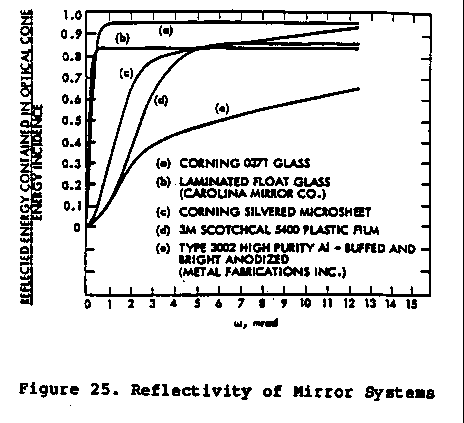
not only the differences in reflectivity but also that for some materials the reflected energy falls within a small solid angle* (Figure 26). These materials allow a small target area for
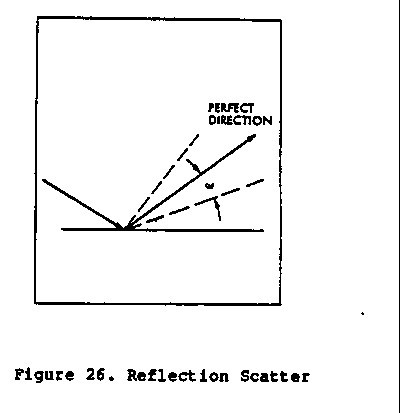
receipt of the reflected rays. If a larger solid angle is required to enclose the reflection, then a compromise between target size and loss of reflected rays must be made. Energy which is not reflected is converted to heat at the reflecting surface. This may require positive cooling efforts to ease or eliminate thermal stress.
COST[edit | edit source]
Concentrator cost represents only one portion of the cost of a system. The cost of the quantity of heat delivered at the required temperature is the preferred method of determining cost. For a given system, the cost per million kilowatt-hours, or kWh (per million Btu) usually decreases as the total number of kWh (Btu) delivered increases, i.e., as system size increases. Similarly, the cost per million kWh (per million Btu) is likely to be less at lower temperatures than at higher temperatures. In general, the higher the concentration and complexity, the higher the cost.
(*) If you have an angle, one side of which is vertical and the other side not vertical, and that side is rotated around the vertical (maintaining the same angle), the angle created is called the solid angle.
Cost is frequently represented by purchase price but not always. Sellers may reduce selling price to penetrate a market, to expand market share, to anticipate future manufacturing economies and cost reductions, and to limit or exclude potential competition. Sellers with a monopoly or a preferred position may sell at higher than reasonable rates. Sellers faced with unknown or indeterminate risks and liabilities for the product will try to transfer the risk to the purchaser through higher prices or other means.
In the United States, many solar energy systems are cost effective only because of federal and state tax policies to aid the solar energy industry. These systems cost two to five times more than competing energy systems. However, energy costs in many less-developed countries are several times greater than in the United States, and therefore solar systems may be cost effective in those countries.
In the United States, the cost of a solar thermal electric system utilizing relatively new technology and incorporating research and development costs would range from $10 to about $30 per watt. The central receiver experiment in California (Solar One) cost about $15 per watt; a proposed 100-megawatt plant incorporating the lessons of Solar One and the economies of a ten-fold increase in size is anticipated to cost about $4 per watt. Heliostats were about one-third of the total cost of Solar One, and are expected to be about one-half the cost of the large plant. (A coal-fired electric plant costs about $1.00-$1.40 per watt of installed capacity.)
Studies of dish technologies indicate costs ranging to $50 per watt for the system, with dish costs of one-third to one-half of the system cost. Dish technology is well behind heliostat experience. Parabolic troughs appear to cost about $538 per square meter ($50 per square foot) at present with possible reduction to about $270 per square meter ($25 per square foot) with a larger market. Again, these costs reflect only one-third to one-half the system cost.
Of possible interest to developing countries is the class of collectors using transparent plastic in cylindrical form with the reflector film partially located in the lower arc and a "black" tube located at the focus. This type of collector appears to offer low cost. Some versions using an evacuated glass tube with an inner blackened copper tube in "once through" (straight tube) or bayonet style are commercially available in the United States (Figures 27, 28, and 29).
The hemispherical bowl has been tested in Crosbyton, Texas, by the U.S. Department of Energy. The unit, 20 meters in diameter, produced high temperatures and high pressure steam suitable for modern steam turbines. The compound curvature is difficult to build, as is the two-axis tracking required of the receiver. However, a tracking receiver is simpler than a tracking concentrator. The concentrator may be more acceptable in smaller size and lower concentration (temperature). The reduction in concentration will decrease temperature, which increases the number of materials that can be used for the receiver, and may ease fabrication of the sphere.
To compare solar thermal technologies, costs should be reduced to common bases such as cost per watt electric or per kWh (Btu). The base should distinguish between average and peak capacity; the amount of storage incorporated; temperature, if heat is the desired end product; and the yearly energy delivered. Other technologies have their own bases; photovoltaics use cost per peak watt, and installed cost per annual kilowatt-hour produced. Electricity from wind energy, as well as from other solar electric technologies, may have different value to the user depending on the time of generation. These considerations should be included in any evaluation methodology for selection of cost-effective systems.
V. COMPARING THE ALTERNATIVES[edit | edit source]
Simple flat plate collectors are the most widely used and most cost-effective solar collectors. Their primary use is for domestic and commercial (e.g., hospitals, restaurants, etc.) hot water applications; however they may also be used in preheat systems for higher temperature applications. They can achieve a temperature of about 38 [degrees] C (100 [degrees] F) above the ambient by capturing sunlight, converting sunlight to heat, and carefully minimizing unwanted heat loss from the collector.
Flat plate (usually non-tracking) collectors are the simplest to fabricate. Simple, unsophisticated, functioning collectors can easily be built with simple tools. Care must be taken to enhance solar collection and prevent thermal losses. Careful use of local materials to the maximum extent possible can reduce cost. While selective absorbers enhance performance and yield higher temperature, almost any "black" surface will perform adequately. Some simple, low-cost flat plate collectors may be better than concentrators for temperatures below 93 [degrees] C (200 [degrees] F), particularly in less-industrialized countries. Expectations of better performance for flat plate (non-concentrating) collectors over concentrating collectors, for the same temperature application, have not been verified in practice. The expectations were based on utilization of both direct and diffuse radiation by flat plate collectors and use of only direct radiation by concentrators.
BIBLIOGRAPHY/SUGGESTED READING LIST[edit | edit source]
Reports and Conference Proceedings
Dougherty, D.A. Line-Pocus Receiver Heat Losses. SERI/TR-632-868. Golden, Colorado: Solar Energy Research Institute, July 1982.
Murphy, L.M. Technical and Cost Potential for Lightweight, Stretched-Membrane Heliostat Technology. SERI/TP-253-2070. Golden, Colorado: Solar Energy Research Institute, January 1984.
Scholten, W.B. A Comparison of Energy Delivery Capabilities of Solar Collectors. McLean, Virginia: Science Applications, Inc., 1983.
Solar Energy Research Institute. Solar Thermal Technology Annual Evaluation Report, Fiscal Year 1983. Golden, Colorado: Solar Energy Research Institute, August 1984.
Truscello, V.C. "Status of the Parabolic Dish Concentrator." Proceedings of the Energy Research and Development Agency Conference on Concentrating Solar Collectors. Georgia Institute of Technology, September 26-28, 1977. Washington, D.C.: U.S. Department of Energy, undated (circa 1982-1983).
U.S. Department of Energy. Solar Parabolic Dish Annual Technology Evaluation Report, Fiscal Year 1982. DOE/JPL1060-63. Washington, D.C.: U.S. Department of Energy, September 15, 1983.
U.S. Department of Energy/Sandia Laboratories. Proceedings of the Line-Focus solar Thermal Energy Technology Development Conference, A Seminar for Industry (September 9-11, 1980). Washington, D.C.: U.S. Department of Energy, September 1980.
Books[edit | edit source]
Duffie, J.A., and Beckman, W.A. Solar Engineering of Thermal Processes. New York, New York: John Wiley and Sons, 1980.
Kreith, F., and Kreider, J.F. Principles of Solar Engineering. Washington, D. C.: Hemisphere Publishing Corp., 1978.
Lunde, P.J. Solar Thermal Engineering. New York, New York: John Wiley and Sons, 1980.
Meinel, A.B., and Meinel, M.P. Applied Solar Energy. Reading, Massachusetts: Addison-Wesley Publishing Co., 1976.
SOURCES OF INFORMATION[edit | edit source]
Government Printing Office
Washington, D.C. 20402 USA
Jet Propulsion Laboratory
4800 Oak Grove Drive
Pasadena, California 91103 USA
National Technical Information Service
5285 Port Royal Road
Springfield, Virginia 22161 USA
Solar Energy Industries Association
1717 Massachusses Avenue N.W.
Washington, D.C. 20036 USA
Solar Energy Research Institute
1617 Cole Boulevard
Golden, Colorado 80401 USA
U.S. Department of Energy
Office of Thermal Systems
1000 Independence Avenue, S.W.
Washington, D.C. 20585 USA
See also[edit | edit source]
Energy Conversion Engineering Conference, 1990. IECEC-90. Proceedings of the 25th Intersociety
Publication Date: 12-17 Aug 1990
Volume: 5, On page(s): 185-195
ISBN: 0-8169-0490-1]